【Ray Tracing The Next Week 超详解】 光线追踪2-6 Cornell box
Chapter 6:Rectangles and Lights
今天,我们来学习长方形区域光照
先看效果
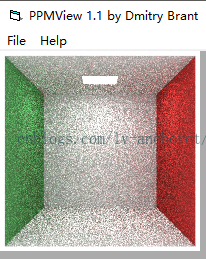
light
首先我们需要设计一个发光的材质
/// light.hpp // -----------------------------------------------------
// [author] lv
// [begin ] 2019.1
// [brief ] the areaLight-class for the ray-tracing project
// from the 《ray tracing the next week》
// ----------------------------------------------------- #pragma once namespace rt
{ //the statement of areaLight class class areaLight :public material
{
public:
areaLight() { } areaLight(texture* mat) :_emit(mat) { } virtual bool scatter(const ray& InRay, const hitInfo& info, rtvec& attenuation, ray& scattered)const { return false; } virtual rtvec emitted(rtvar u, rtvar v, const rtvec& p)const { return _emit->value(u, v, p); } private:
texture* _emit;
}; } // rt namespace
关于设计方面,我们需要把发光函数设为可继承虚函数,基类也要添加,但是不是所有的材质都需要发光,所以,基类中的发光函数并不需要设置为纯虚
/// material.hpp // -----------------------------------------------------
// [author] lv
// [begin ] 2018.12
// [brief ] the material-class for the ray-tracing project
// from the 《ray tracing in one week》
// ----------------------------------------------------- #pragma once namespace rt
{ // the statement of material class class material
{
public: /*
@brief: produce a scattered ray
@param: InRay -> Incident light
info -> the information of intersect-point(hit-point)
attenuation -> when scattered, how much the ray should be attenuated by tis reflectance R
scattered -> as we talk, it is a new sight; or
it is the scattered ray with the intersect-point
@retur: the function calculate a scattered ray or not
*/
virtual bool scatter(const ray& InRay, const hitInfo& info, rtvec& attenuation, ray& scattered)const = ; /*
@brief: 自发光
@param: 纹理所需信息
@retur: 纹理像素值
*/
virtual rtvec emitted(rtvar u, rtvar v, const rtvec& p)const { return rtvec(); } }; }
这样的话,一般的材质继承之后,发光为黑色即不发光,较为合理
我们既然添加了光照,那么计算插值函数时候也要将它加进去
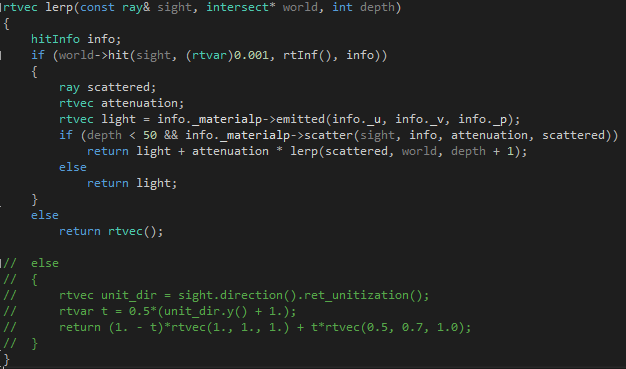
到此,我们的发光材质就设置妥当了
rectangle
我们定义的长方形均为平行于轴的
(引用书上一张图)
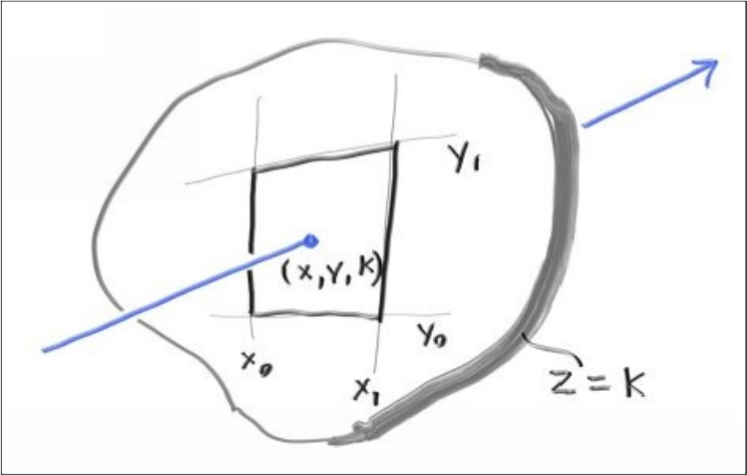
假设长方形位于 z = k 平面,x和y边界如上,交点为P(x,y,k)
我们如何确定光线参数t?
已知:
光线:p(t) = eye + t * direction
则,z方向的方程为:z(t) = eye.z + t * direction.z
那么,若满足z = k,则
t = (k - eye.z) / direction.z
同理可得x和y的等式
如果,得到的x坐标或者y坐标不在边界之内,那么就没有相交,反之则光线和长方形相交
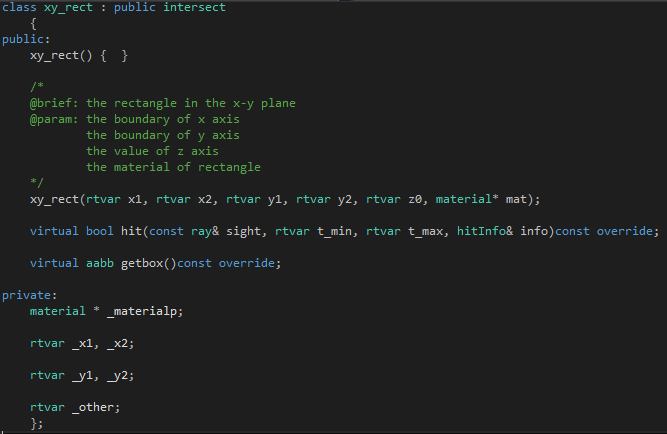

上面的代码都比较简单,那个 hit 呢,就是,根据已知的一个分量求出t,然后,把这个解带入求出对应的其他两个分量,如果其他两个分量不在边界内,那么返回false
反之,我们求取该点的纹理坐标,以及其他碰撞点信息记录之
获取包围盒嘛,理论上面无厚薄,线无粗细,但是实际中面有厚薄,我们可以将厚度设置为0.0002,以此模拟理论厚度
同理写出其他两个平面类即可。
这个没什么问题,我们就往下进行
我们来做Cornell box

相机参数设置:

得到的图如下:
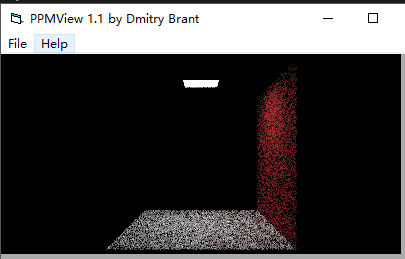
有几个面是黑色的??也就是根本没画出来
我们细细看一下,发现,长方形的法向量是关键
比如画出来的红墙,对面与之平行的面的法线是朝左边的,展现在我们视线中的是背面
所以,我们有时候需要反转一下法向量
/// flip_normal.hpp // -----------------------------------------------------
// [author] lv
// [begin ] 2019.1
// [brief ] the flip_normal-class for the ray-tracing project
// from the 《ray tracing the next week》
// ----------------------------------------------------- #pragma once namespace rt
{ class flip_normal: public intersect
{
public:
flip_normal(intersect * p) :_p(p) { } virtual bool hit(const ray& sight, rtvar t_min, rtvar t_max, hitInfo& info)const override
{
if (_p->hit(sight, t_min, t_max, info))
{
info._n = -info._n;
return true;
}
return false;
} virtual aabb getbox()const override
{
return _p->getbox();
} private:
intersect* _p;
}; } // rt namespace
这样就可以了,我们改一下场景
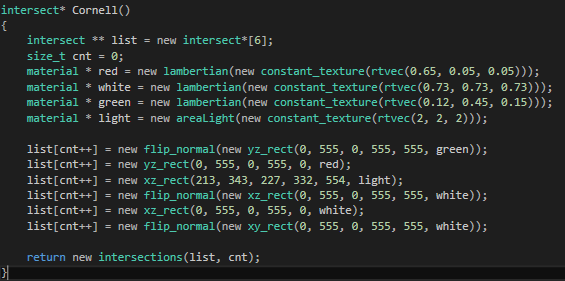
如下:
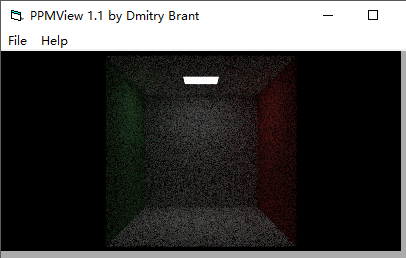
此外,我们还需要注意的是,light对应的纹理中的数值越大光强越强
我们可以试一下
material * light = new areaLight(new constant_texture(rtvec(, , )));
如下:
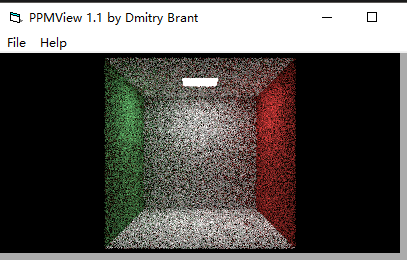
可以看出来两张图对比之下,第二张亮多了
但是我们依旧看着很不舒服,好多黑点点,太难受了
我想啊想,为什么这么多黑点??可能是因为背景是黑色的,毕竟是漫反射,如果随机反射失败那就是黑色,所以随机反射点可能产生好多黑色小点,你千万别想着换成镜面材质,那个更无语
所以啊,我想了下,把背景改为白色,那样更好,毕竟色彩中掺杂一点白色,无伤大雅
如是,我改了下,效果可观
此法只适用于Cornell box本身,具体场景下的画面优化请见下一篇
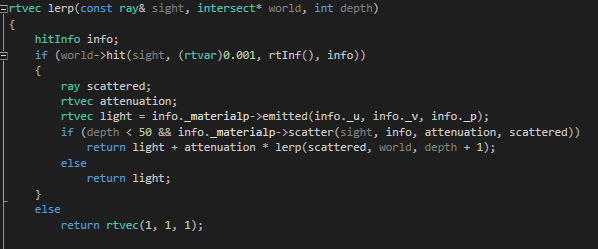

感谢您的阅读,生活愉快~
【Ray Tracing The Next Week 超详解】 光线追踪2-6 Cornell box的更多相关文章
- 【Ray Tracing The Next Week 超详解】 光线追踪2-9
我们来整理一下项目的代码 目录 ----include --hit --texture --material ----RTdef.hpp ----ray.hpp ----camera.hpp ---- ...
- 【Ray Tracing in One Weekend 超详解】 光线追踪1-4
我们上一篇写了Chapter5 的第一个部分表面法线,那么我们来学剩下的部分,以及Chapter6. Chapter5:Surface normals and multiple objects. 我们 ...
- 【Ray Tracing The Next Week 超详解】 光线追踪2-7 任意长方体 && 场景案例
上一篇比较简单,很久才发是因为做了一些好玩的场景,后来发现这一章是专门写场景例子的,所以就安排到了这一篇 Preface 这一篇要介绍的内容有: 1. 自己做的光照例子 2. Cornell box画 ...
- 【Ray Tracing The Next Week 超详解】 光线追踪2-8 Volume
Preface 今天有两个东东,一个是体积烟雾,一个是封面图 下一篇我们总结项目代码 Chapter 8:Volumes 我们需要为我们的光线追踪器添加新的物体——烟.雾,也称为participat ...
- 【Ray Tracing The Next Week 超详解】 光线追踪2-5
Chapter 5:Image Texture Mapping 先看效果: 我们之前的纹理是利用的是撞击点p处的位置信息,比如大理石纹理 而我们今天的图片映射纹理采用2D(u,v)纹理坐标来进行. 在 ...
- 【Ray Tracing in One Weekend 超详解】 光线追踪1-8 自定义相机设计
今天,我们来学习如何设计自定义位置的相机 ready 我们只需要了解我们之前的坐标体系,或者说是相机位置 先看效果 Chapter10:Positionable camera 这一章我们直接用概念 ...
- 【Ray Tracing The Next Week 超详解】 光线追踪2-4 Perlin noise
Preface 为了得到更好的纹理,很多人采用各种形式的柏林噪声(该命名来自于发明人 Ken Perlin) 柏林噪声是一种比较模糊的白噪声的东西:(引用书中一张图) 柏林噪声是用来生成一些看似杂乱 ...
- 【Ray Tracing The Next Week 超详解】 光线追踪2-3
Preface 终于到了激动人心的纹理章节了 然鹅,看了下,并不激动 因为我们之前就接触过 当初有一个 attenuation 吗? 对了,这就是我们的rgb分量过滤器,我们画出的红色.蓝色.绿色等 ...
- 【Ray Tracing The Next Week 超详解】 光线追踪2-2
Chapter 2:Bounding Volume Hierarchies 今天我们来讲层次包围盒,乍一看比较难,篇幅也多,但是咱们一步一步来,相信大家应该都能听懂 BVH 和 Perlin text ...
随机推荐
- mysql 架构~多写模式MGR
一 简介:今天咱们来聊聊MGR的单主切换和新节点加入二 单主模式下变成多主: 1 3306 STOP group_replication; set global group_replicati ...
- AD域相关的属性和C#操作AD域
“常规”标签 姓 Sn 名 Givename 英文缩写 Initials 显示名称 displayName 描述 Description 办公室 physicalDeliveryOfficeNam ...
- python中的魔法参数:*args和**kwargs
python中的魔法参数:*args和**kwargs def foo(*args, **kwargs):print 'args = ', argsprint 'kwargs = ', kwargsp ...
- 【vim】按时间回退文本 :earlier 1m
Vim 会记录文件的更改,你很容易可以回退到之前某个时间.该命令是相当直观的.比如: :earlier 1m 会把文件回退到 1 分钟以前的状态. 注意,你可以使用下面的命令进行相反的转换: :lat ...
- Linux内存管理2---段机制
1.前言 本文所述关于内存管理的系列文章主要是对陈莉君老师所讲述的内存管理知识讲座的整理. 本讲座主要分三个主题展开对内存管理进行讲解:内存管理的硬件基础.虚拟地址空间的管理.物理地址空间的管理. 本 ...
- (DT系列五)Linux kernel 是怎么将 devicetree中的内容生成plateform_device【转】
转自:https://blog.csdn.net/lichengtongxiazai/article/details/38942033 Linux kernel 是怎么将 devicetree中的内容 ...
- oracle的读写分离实现
在MySQL作为应用系统的后台数据库时,我们常常见到这样的架构,一拖二.一拖三等等.这是用MySQL的读写分离技术,实现数据的写入和读取分别在不同的库上,提升了数据库服务能力. 同样,在Oracle作 ...
- 单个 LINQ to Entities 查询中的两个结构上不兼容的初始化过程中出现类型“XXXX”
最近在做一个报表的时候,用EF使用了Contact方法,但是程式运行一直出错.最近终于找到原因了,写下来提醒下自己.好了,进入正题: 现在我举个栗子,目前数据库中有ParentStudent表和Sub ...
- zabbix系列(二)zabbix3.0.4添加对mysql数据库性能的监控
zabbix3.0.4添加Mysql的监控 zabbix3.0 server已自带mysql的模板了,只需安装agent端,然后在web端给主机增加模板就行了. Agent端操纵 /etc/zabbi ...
- 洛谷 P4427 求和
传送门啦 思路: 开始不肿么容易想到用倍增,但是想到需要求 $ Lca $ ,倍增这种常数小而且快的方法就很方便了.求 $ Lca $ 就是一个最普通的板子.那现在考虑怎么求题目中的结果. 树上差分可 ...
